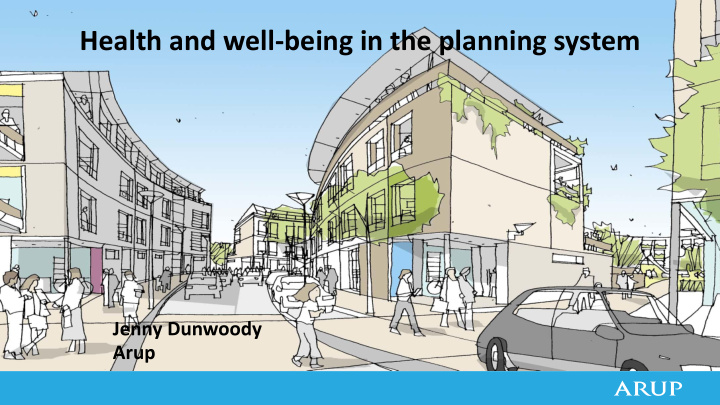



Health and well-being in the planning system Jenny Dunwoody Arup
‘ Health is a state of complete physical, mental and social well-being and not merely an absence of disease or infirmity’ WHO, 1948 2
Environment and spatial planning Environmental Impact Assessment (EIA) • Established in 1985 (Directive 85/337/EEC) • Applies to certain types of major planning application • Ensures that the environmental implications of decisions are taken into account before the decisions are made Strategic Environmental Assessment (SEA) • Established in 2001 (Directive 2001/42/EC) • Applies to plans, policies and programmes • Ensures that plans likely to have significant effects on the environment are made subject to an environmental assessment, prior to their approval or authorisation 3
Noise Landscape Air quality and visual Health…? Socio- Traffic and economic transport effects Ecology 4
Dahlgren & Whitehead Rainbow (1991) 5
Emergence of health impact assessment • HIA developed in parallel to EIA • A non-statutory process • Driven by growing recognition of the link between healthy places and healthy people 6
Health impact assessment (HIA) 7
Health assessment process Impacts on Population Potential Recommen health distribution Evidence health -dations determinants /sensitivity outcomes 8
Air quality Housing Employment Green space Access to services Social cohesion Active travel 9
Evidence Health determinants Health outcomes Mental wellbeing, Physical activity cardiovascular health Vehicle emissions Respiratory health Mental and physical Social networks health 10
Evidence ‘Although there is a multitude of guidance supporting and advocating action on the built and natural environment to improve health outcomes, the evidence base underpinning these principles is still a matter of debate amongst the scientific and practitioner communities. The unique and individual nature of the built and natural environment make it difficult to develop evidence-based approaches that can be universally applied, and successful practices in one community setting may not always be transferrable to another.’ PHE, 2017 11
Integration of health in the planning system – milestones The Marmot Review (2010) • People living in the poorest neighbourhoods in England will on average die seven years earlier than people living in the richest neighbourhoods • People living in poorer areas spend more of their lives with disability - an average total difference of 17 years • Action needed beyond the reach of the NHS, across all the social determinants of health, including education, occupation, income, home and community 12
Integration of health in the planning system – milestones Health and Social Care Act (2012) • Public health functions moved from the NHS into local authorities • Joint Strategic Needs Assessments & Joint Health and Wellbeing Strategies • Established Public Health England - advises national and local government and the NHS on health improvement; collects data to improve understanding of public health Revised EIA Regulations (2017) • Requirement to assess the ‘likely significant effects’ of major developments on ‘population and human health’ 13
Consultation & community engagement • Insight into local health issues and priorities • Community involvement in developing solutions 14
Strategic & policy level assessment • Integrated Impact Assessment of development plans – including environmental, sustainability, health and equalities • Health in All Policies (WHO) – approach adopted by local authorities to systematically take into account the health implications of decisions 15
Is it working? Increased focus on wider Local authority planning and health determinants of health in new not yet working together. developments Only 27% of Local Authorities in - Walking and active travel England follow requirement to refer to Health Needs Assessments in their - Green space local plans (TCPA, 2019) - Transport and access - Services & community space Limited impact on existing - Employment communities - Affordable housing 16
Recommend
More recommend